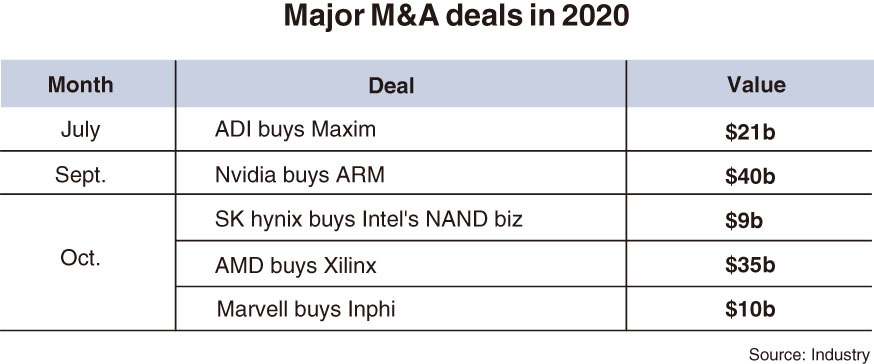The COVID-19 pandemic in 2020 has proven the importance of semiconductors.
While the novel coronavirus has roiled many other industries, the chip industry has not just survived, but thrived owing to a surge in demand for noncontact businesses.
Despite the border shutdowns, the world’s leading chipmakers -- regardless of which specific segments of the markets they are playing in -- have been silently preparing for a new chapter in the industry’s growth after the COVID-19 crisis.
A recent report by global consulting firm McKinsey & Company suggests chipmakers that begin revising their long-term strategies now may emerge stronger in the next normal.
And one of the successful scenarios for them is to undertake pragmatic mergers and acquisitions.
Including the latest announcement by South Korean chipmaker SK hynix of a deal to acquire Intel’s NAND storage business, there are major moves being made in the M&A market that could reshape different segments of the chip industry or the entire market.
These changes could both directly and indirectly influence Korean semiconductor companies and their presence in the global market down the road.
The Korea Herald has looked into some potential changes in the chip industry and how they are likely to affect Korean players.
2020 to be highest year for M&As In the system-on-chip market, sizable mergers and acquisitions are underway.
In September, Silicon Valley-based graphic chip developer Nvidia announced its acquisition of UK-based chip design firm ARM for $40 billion.
ARM, which used to be owned by Japan’s SoftBank, was the world’s largest provider of chip designs for mobile application processors and central processing units for PCs. Not surprisingly, the company’s chip design is now being used for over 90 percent of mobile devices, including those manufactured by Samsung.
Nvidia, after outperforming competitors in the gaming industry, is now aggressively jumping into the autonomous driving world. And it seems to be seeking synergy with ARM’s capabilities in developing the brains of mobile devices -- which would be great support for Nvidia’s dreams for unmanned driving technologies.
Another major merger, between AMD and Xilinx, is about to shake the market.
US CPU and GPU maker AMD decided to take over Xilinx, a provider of microchips called field-programmable gate arrays, for $35 billion. Xilinx’s FPGAs are used in 5G telecommunications infrastructure, since they can be reprogrammed for such fast-emerging technologies without years of development.
AMD’s Xilinx takeover would put the former company in a more competitive position against Intel in the CPU market, market watchers say.
In the memory market, SK hynix’s announcement that it was acquiring Intel’s NAND storage business for $9 billion took the market by surprise last month. With the takeover, SK hynix aims to become the world’s second-biggest NAND memory provider after Samsung.
Before the AMD-Xilinx deal, the aggregate value of M&A deals in the semiconductor market reached $63 billion. The total figure now exceeds $115 billion with the addition of the AMD-Xilinx deal.
With these deals, 2020 is to be the highest year for semiconductor M&As, breaking 2016’s record.
What about Samsung?Before the COVID-19 crisis, Korea’s biggest chipmaker, Samsung, was mentioned as a potential buyer of fabless firms like Xilinx and NXP.
Samsung’s announcement of a 133 trillion won investment in the system-on-chip business in April 2019 had led to speculation that the Korean memory chip giant would roll up its sleeves to acquire a smaller but competitive player in the non-memory segment.
Despite the expectations, no such announcement came from Samsung over the past year.
“Considering Samsung’s No. 1 position in the global memory market, its participation in a sizable M&A deal could be strictly controlled by other countries’ authorities in terms of antitrust issues,” said an industry official.
In 2016, US-based Qualcomm attempted to acquire NXP, an Amsterdam-based fabless company that specializes in automotive chips, but failed due to disapproval from the Chinese government.
Samsung denies making efforts to undertake any M&As, citing the ongoing legal risks involving de facto leader Lee Jae-yong.
However, industry watchers in the financial market think it would be reasonable for Samsung to examine what it really needs to take over while gauging the timing.
“Samsung seems it still has interests in the automotive chip market with its goal of producing autonomous driving chips,” a financial source told The Korea Herald. “To make synergy with its Harman acquisition, automotive chips firms like NXP would be a likely choice for Samsung.”
Some market observers forecast that Samsung could benefit from the AMD-Xilinx and SK hynix-Intel deals.
As Samsung is ramping up its capacity in the chip foundry market to catch up with Taiwan’s TSMC, fabless AMD’s expansion could boost the overall foundry industry, according to Lee Jae-yoon, an analyst at Yuanta Securities.
“Considering AMD’s relations with Samsung in GPU production, the company’s growth could benefit Samsung in other businesses as well,” Lee said.
Intel, an archrival of AMD, could also rely more on Samsung’s foundry service for its CPU production, he said.
By Song Su-hyun (
song@heraldcorp.com)





![[Herald Interview] How Gopizza got big in India](http://res.heraldm.com/phpwas/restmb_idxmake.php?idx=644&simg=/content/image/2024/11/20/20241120050057_0.jpg)


![[KH Explains] Dissecting Hyundai Motor's lobbying in US](http://res.heraldm.com/phpwas/restmb_idxmake.php?idx=644&simg=/content/image/2024/11/20/20241120050034_0.jpg)